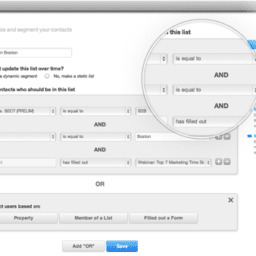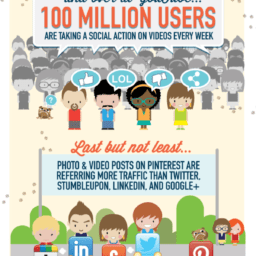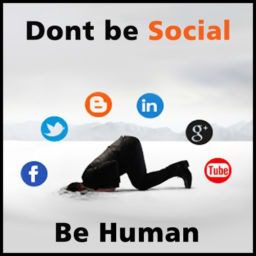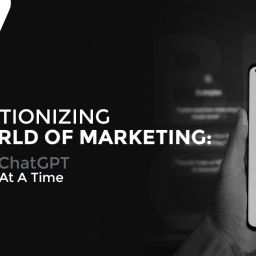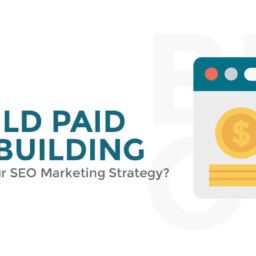
I have been asked this question a lot lately, “Where do you think marketing is headed?” and “What is the future of digital marketing?
Here are 33 statistics that give you a glimpse into where the future of marketing is headed by hubspot.
Social Media and Social Lead Nurturing
1) Failure to respond via social channels can lead to up to a 15% increase in churn rate for existing customers. (Source: Gartner) Tweet This Stat!
2) 37% of brands would like to use social media engagement to create customer-tailored marketing campaigns. (Source: Forrester) Tweet This Stat!
3) 75% of B2B companies do not measure or quantify social media engagement. (Source: Satmetrix) Tweet This Stat!
4) 51% of the top 20% of B2B marketers generating leads through social media use social sharing tools, compared to the industry average of 39%. (Source: Aberdeen) Tweet This Stat!
5) 84% of B2B marketers use social media in some form. (Source: Aberdeen) Tweet This Stat!
6) Marketers spend an average of 4-6 hours a week on social media. (Source: Social Media Examiner) Tweet This Stat!
7) Currently, marketers allocate 7.6% of their budgets to social media. CMOs expect that number to reach 18.8% in the next five years. (Source: CMO Survey) Tweet This Stat!
8) 60.2% of marketers are looking for analysis options, as well as other analytics options, in their social media management tools. (Source: SEOmoz) Tweet This Stat!
9) Regardless, marketers still continue to struggle with integrating social media into the company’s overall strategy. On a scale of 1-7, only 6.8% of respondents believe that social media is “very integrated” into their strategy (the highest rank for the question), while 16.7% believe that it’s not integrated at all (the lowest rank for the question). (Source: CMO Survey) Tweet This Stat!
What These Social Media Stats Say About the Future of Marketing

Personalization, Relevancy and Dynamic Content
10) Personalized emails improve click-through rates by 14%, and conversion rates by 10%.
(Source: Aberdeen) Tweet This Stat!
11) The top reasons for U.S. email users to unsubscribe from a business or non-profit email subscription are too many emails (69%) and content that is no longer relevant (56%). (Source: Chadwick Martin Bailey) Tweet This Stat!
12) 80% of mobile internet users would prefer ads relevant to them locally. (Source: JiWire) Tweet This Stat!
13) A high-impact recommendation from a trusted friend conveying a relevant message is up to 50 times more likely to trigger a purchase than a low-impact recommendation. (Source: McKinsey Quarterly) Tweet This Stat!
14) 62% of adults under 34 are willing to share their location to get more relevant content. (Source: JiWire) Tweet This Stat!
15) 53% of retailers plan to focus on web personalization engines in 2012. (Source: National Retail Federation) Tweet This Stat!
16) 75% of people prefer to receive offers over any other form of call-to-action. (Source: Text Marketer) Tweet This Stat!
17) In a study of 650 multi-channel marketing campaigns, personalized campaigns consistently and overwhelmingly beat out static campaigns in generating a high response rate from recipients. See a breakdown by industry here. (Source: MindFire). Tweet This Stat!
What These Personalization, Relevancy, & Dynamic Content Stats Say About the Future of Marketing

Email Marketing and Automation
18) 59% of B2B marketers say email is the most effective channel for generating revenue. (Source: BtoB Magazine) Tweet This Stat!
19) 49% of B2B marketers spend more time and resources on email than on other channels. (Source: BtoB Magazine) Tweet This Stat!
20) Triggered email messages get 119% higher click-through rates than “business as usual” messages. (Source: Epsilon) Tweet This Stat!
21) More than 50% of respondents said they had not yet realized the value of their investment in marketing automation. (Source: Genius) Tweet This Stat!
22) 61% of marketing companies plan to increase their email marketing efforts in the next year. (Source: Experian) Tweet This Stat!
23) The adoption of marketing automation technology is expected to increase by 50% by 2015. (Source: Sirius Decisions) Tweet This Stat!
What These Email Marketing & Automation Stats Say About the Future of Marketing

Marketing Analytics and Integration
24) CMOs report they spend 8% of their marketing budgets on marketing analytics, and expect to increase this level in the next three years. (Source: CMO Survey) Tweet This Stat!
25) Spending on marketing analytics is expected to increase 60% by 2015. (Source: CMO Survey) Tweet This Stat!
26) By 2013, lead management campaigns integrating 4 or more digital channels will outperform single- or dual-channel campaigns by 300%. (Source: Gartner) Tweet This Stat!
27) By 2014, over 40% of large complex marketing organizations will have developed a pace-layered application approach to integrated marketing. (Source: Gartner) Tweet This Stat!
What These Marketing Analytics & Intregration Stats Say About the Future of Marketing

Mobile Marketing and Apps
28) Worldwide mobile advertising revenue will expand 3.5X its present size by 2016. (Source: Yankee Group) Tweet This Stat!
29) Mobile commerce will account for 24.4% of overall ecommerce revenues by the end of 2017. (Source: ABI Research) Tweet This Stat!
30) Email opens on smartphones and tablets have increased 80% over the last six months. (Source: Litmus) Tweet This Stat!
31) 45% of US businesses are conducting some form of mobile marketing, with mobile websites (70%), mobile applications (55%), and QR codes (49%) being the most common tactics. (Source: StrongMail) Tweet This Stat!
32) 47% of marketing companies plan to increase their efforts in mobile apps in the next year. (Source: Experian) Tweet This Stat!
33) 59% of U.S. marketing companies collect mobile contact information. (Source: Experian) Tweet This Stat!
What These Mobile Marketing & Apps Stats Say About the Future of Marketing
Everyone has a smartphone! Yes, we know. We also know that more people are seeing ads on their phones, and that websites need to be mobile optimized. But that’s just the consumer experience. What about the business experience? What about the marketers who need to understand how people are interacting with them on mobile? Or what about marketers who are running around planning and implementing strategies, and need a mobile app tied to their analytics and automation software to see exactly how their strategies are playing out? Marketers need an application that enables them to keep tabs on their lead generation and customer conversions on the go.
All in all, marketing is undergoing a powerful transformation. There are needs to be met, ideas to be created, and revolutions coming out way. Once upon a time, we discussed how social media was a shiny new toy, email marketing was reincarnating into something valuable, and mobile apps were fun to click on. Now it’s time to connect all these different parts. It’s time to see how each supports one another to execute the perfect marketing campaign — and watch how it does so by reveiwing the metrics in an integrated analytics platform. Easy. Powerful. Integrated. That’s what marketing needs.
Where do you see the future of marketing going? Where do you want it to go?
Blog source : Hubspot.


